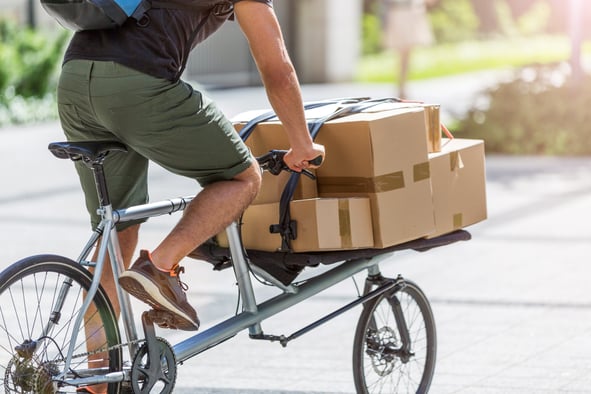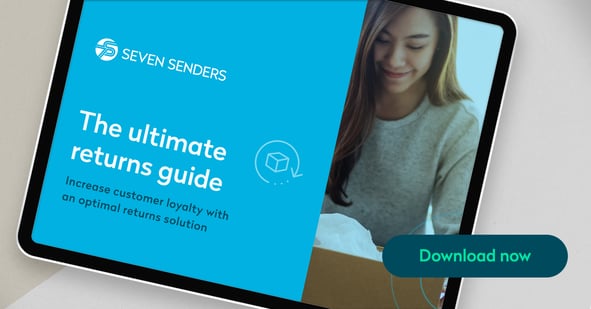Anyone who wants to grow internationally and ship across national borders knows that this depends on many different factors and can be challenging. The new trend topics in the logistics industry offer answers to counteract many of these challenges. Be prepared and take a look at the trends that could come your way in logistics and e-commerce.
1. Consumer expectations are constantly rising
Due to repeatedly surpassing top performance in the logistics sector, consumers also expect medium-sized online shops to ship their goods sustainably and quickly, free of charge and at the said time. Meeting these expectations is especially challenging at peak times or during the current Corona pandemic.
Online shops can create a clear competitive advantage if logistics processes and the customer journey are adapted to the consumer's wishes and ideas and turn a one-time buyer into a loyal customer. For example, offering the favorite payment method can bring online shops an increase in the conversion rate in the checkout of up to 44%.
It is more difficult to optimize the logistics process for your customers, as each country has different shipping requirements. With different local carriers in the various European countries, this goal can be achieved and every need fulfilled.
Through the large carrier network of Seven Senders, the many carriers can act flexibly in difficult times and fulfill wishes such as a particularly low CO2 delivery on the last mile. The delivery by the local carriers is perfectly adapted to the habits of your European customers and can ensure one or the other recommendation of your online shop.
2. The desire for sustainability continues
Sustainability continues to be a trend and a consumer requirement, which will remain an important topic this year. As DPD's E-Shopper Barometer 2019 study shows, online shoppers want the goods they order to have the smallest possible impact on the environment. According to the study, 66 per cent of the 23,000 respondents from 21 countries prefer to buy from sustainable brands and retailers.
Even if cross-border deliveries and sustainability do not seem to be compatible at first glance, interesting new solutions can be considered especially on the last mile. These include the use of electric vehicles and bicycle couriers that minimise CO2 emissions during last mile delivery.
This not only makes a positive contribution to protecting the environment, it can also be solved cost-effectively. In addition, these two variants are very quiet and are suitable for delivery in the evening hours.

This means that delivery can also be adapted to the desired times of people who work during the day. Additionally, if every parcel is delivered on the first try, there is no need to make unnecessary multiple trips. By communicating with the customer, the place and time of delivery can be agreed upon and unnecessary emissions of CO2 can be avoided.
For example, parcels can be dropped off at PUDO (PickUp DropOff) locations as desired and then picked up by the customer at the desired time. In this way, the carrier only has to make the journey once and the parcel is guaranteed to land at the customer's premises.
Concrete examples include the Italian provider Milkman. Here, customers can use live tracking to change the place and time of delivery up to half an hour before the announced delivery date in order to receive the package safely.
Another example is the carrier Budbee. In Sweden, the Netherlands, Finland and Denmark, it announces to its customers the arrival of their parcel in a time window of one hour. Another option is delivery on Sundays or receiving all parcels on a desired date to keep CO2 low.
ASOS sets an excellent example. The fashion e-tailor uses Seven Senders' service to consolidate their shipments and only hand them over to the delivery partners in the country of destination. This way, no empty truck leaves their warehouse and unnecessary empty runs are avoided. An advantage for the environment and the shipping price.
3. Optimizing the last mile
In addition to improving the sustainability aspect, the last mile can also benefit from general optimisation. It is the most important part of the supply chain as it creates a direct touchpoint with the customer and influences customer satisfaction.
Due to various factors such as traffic conditions, special customer requests or even government regulations, last mile delivery can cause unwanted difficulties resulting in a negative customer experience. To avoid this, efficient solutions should be considered to meet or, at best, exceed their customers' expectations.
E-commerce retailers should perform like domestic market leaders in cross-border delivery to remain competitive. This goal can be realised with a direct injection solution. Here, parcels are bundled for customers and sent collectively to the destination country. This ensures faster delivery, as the goods do not have to be taken to an intermediate warehouse and can be delivered directly.
-jpeg.jpeg?width=593&name=AdobeStock_340154284%20(1)-jpeg.jpeg)
Another trend for the last mile are alternatives to trucks and lorries. Drones or providers with cargo bikes can dodge traffic within large cities and deliver the goods in a precise time window. Unused locations in large cities will be part of the last mile in the future, such as the use of parking garages as logistics space. Shipping within large cities will become increasingly complicated and expensive, so efficient rethinking is needed and unused space must be made usable for logistics.
Optimizing the last mile thus involves sustainable, fast and timed delivery that is also cheap and can be adapted each time by the customer. This can also become a reality for medium-sized companies through a broad carrier network and, with the help of one logistics partner, even cost-efficient for customers and companies.
4. Simplified communication during delivery
When a customer orders from your online shop, they always want to know where their parcel is and when it will arrive. There are already options for online shops to keep the customer up to date with fully automated delivery notifications. However, the trend is towards easier availability for the customer and involves the use of more convenient channels.
Here we are talking about chat functions that are partly automated and available at any time. The focus here is particularly on messengers such as WhatsApp or Facebook Messenger. For many online shops, a chat function in their own app is also an interesting way to intensify contact and thus also the bond with the customer.

5. The use of blockchain for the entire supply chain
After much hubbub around blockchain, a widespread rollout of the technology across the supply chain could now come true in 2021, making it more transparent and information-rich for all involved. It is a special form of database that is decentralised and tamper-proof. All participants have access to this database, but through cryptology the information is stored as encrypted data blocks.
Another security feature is that the history is unchangeable and data manipulation is noticed immediately. After an automatic check, changes are saved on all computers simultaneously at intervals and data and transactions are arranged in a continuous chain of blocks. In this way, changes are always traceable. Thus, transparency is used instead of trust.
Particularly with regard to complex logistical processes involving many partners, a technology that maps processes in real time and through which one can fully understand what is happening can be very helpful. For this, however, logistics companies need to digitise their data and establish an industry-wide standard. Once this is implemented, an ecosystem of supply chain partners can be formed and blockchain can be used in a shared environment.
Smart contracts could become a new standard in which communication and trade is carried out through the blockchain. Many processes will be automated and more systems can be created as blockchains are autonomous and highly efficient systems for storing and transacting data. This creates a huge leap in efficiency and will have a positive impact on the shipping experience of many customers. If the conditions are met, this trend can soon be followed.
 Looking for an optimal returns strategy? Learn more here!
Looking for an optimal returns strategy? Learn more here!
6. Increasing efficiency through the IoT
The Internet of Things, or IoT for short, is creating further progress in terms of efficiency within the supply chain. This involves live location tracking, which is made possible by the installation of GPS sensors in various means of transport. We are talking about physical devices that automatically transmit and monitor data. This saves costs and time.
Since the IoT can be used throughout the supply chain, it can be used for everything from inventory management to measuring demand to respond faster to customer needs. Data transmission increases transparency in such processes and provides real-time visibility of goods because when location data is permanently visible during the delivery of goods, problems can be better tracked and responded to. Used correctly, it can increase efficiency and minimize downtime.
Conclusion
Customer expectations are continuously rising and putting the logistics industry and everyone who ships goods under increasing pressure. Customer satisfaction is moving further into focus if you want your company to be successful in the market and expand into other countries.
Advances in emerging technologies offer exciting solutions that are suitable for large and experienced players but are cumbersome to implement or not yet worthwhile for many companies. To keep up, however, it helps to look for a shipping partner that combines many solutions and can support with expertise.
With Seven Senders as a partner, you have the most important logistics solutions, together with detailed advice, in one contact. This means that all customer requirements can be easily met and your supply chain is always up to date.
Do you want to offer your customers the best shipping experience? Contact us now.